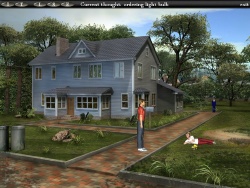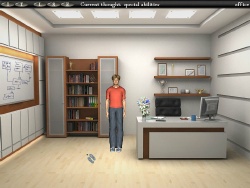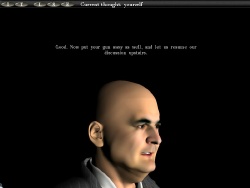|
Diamonds in the Rough
 Made
with the Adventure Game Studio (AGS) software, Diamonds in the Rough is aptly named. It is rough
- from the look, through some aspects of gameplay, to the rather large information dump at the end to
tie it all together. To some extent that is not surprising; this is another small scale independent release.
But it does indeed contain some diamonds, including the start, the final resolution, and parts of the
storyline. I don't think it's as good as some reviewers have claimed, but it is certainly one of the more
thoughtful games I have played recently. Made
with the Adventure Game Studio (AGS) software, Diamonds in the Rough is aptly named. It is rough
- from the look, through some aspects of gameplay, to the rather large information dump at the end to
tie it all together. To some extent that is not surprising; this is another small scale independent release.
But it does indeed contain some diamonds, including the start, the final resolution, and parts of the
storyline. I don't think it's as good as some reviewers have claimed, but it is certainly one of the more
thoughtful games I have played recently.
Diamonds in the Rough centres around Jason, a high school drop out who is approached to work for an
organisation recruiting people with special talents - telekinesis or telepathy being among the more mundane.
To accept the job, which apparently involves little more than developing and using his talent, Jason must
move to a cloistered town, forsaking outside contact in return for a house and all of life's needs taken care
of. Jason needs little convincing and is soon a resident of... well, somewhere. This definitely isn't Mayan
Riviera Mexico, or some other tropical place and he's "not in Kansas anymore", or well, maybe he is.
Like Ghost in the Sheet which I played just prior to this,
Diamonds in the Rough tries to bring a little something different to the table. As well as an inventory,
you have a thoughts window, which you can use to gain information about characters and events, as well as
insights into your own knowledge. In many instances, it's an adjunct of a dialogue tree - use the thought on
a character and it might start a conversation - but it adds more to the gameplay than simply clicking available
conversation options.
The game is essentially a flashback, and the introduction makes it clear that everything is not as it seems. The
benign veneer of a comfortable life hides something less amiable. The more Jason learns, the more he wants to
poke about to determine just exactly what the organisation he works for is all about. It's clear he's not in the
travel business or working at one of the many Puerto Vallarta hotels. Something a lot more suspicious is going
on here and Jason is determined to find out.
 Puzzles
are both inventory based and dialogue based, some interactions being essential to advance the game.
Some are pedantically so; failing to "look" at an object I had tried to take prevented a progression and held
me up for some considerable time. Straight out puzzles exist as well, not too many although the complexity of
the password puzzle will more than make up for any lack of volume. I found it one of the more difficult I have
encountered for quite a while, and if you like a challenge, that puzzle alone will probably satisfy you. Puzzles
are both inventory based and dialogue based, some interactions being essential to advance the game.
Some are pedantically so; failing to "look" at an object I had tried to take prevented a progression and held
me up for some considerable time. Straight out puzzles exist as well, not too many although the complexity of
the password puzzle will more than make up for any lack of volume. I found it one of the more difficult I have
encountered for quite a while, and if you like a challenge, that puzzle alone will probably satisfy you.
I read somewhere that the game nags you if you try and complete that puzzle with a walkthrough, and I
confirmed this by going back and plugging in the password without having done those things that you are supposed
to do. I don't know if it happens anywhere else in the game, but I am not sure what I think of the approach. I
can understand the maker being proud of the puzzle construction, but conversely, how people want to play the
game having paid to do so is up to them. You can make up your own mind.
The construction of some of the other puzzles and conundrums could have benefited from a bit of tweaking here
and there. Every so often you simply have to visit every location to see if something might have changed. I
don't mind retracing my steps, but there needs to be some clue as to a possible path to take, or else it's just
aimless wandering.
Diamonds in the Rough plays in the third person, with point and left-click utilised to move Jason through the
scenes, and a right-click (or some keyboard shortcuts) being used to cycle through various action icons (talk,
look at, walk etc). It's old school, and fits the look of the game. Old school too is the point score that
accumulates as you complete necessary objectives in the game. You will know you have done something that needs
doing by the congratulatory "briiiing" noise. The final score is 400, which as far as I can tell you must have
achieved if you trigger the end game - which if so, means its more a mark of progress through the game than an
indication of how many things you missed along the way.
 The
rendered backgrounds are predominantly static, with movement in the game coming from the characters themselves.
The motion is fairly basic; Jason moves his legs and sort of glides from place to place. I would have liked a map to
be able to jump him about, but the town in which the game takes place is not terribly big, so walking isn't too much
of a chore. Helpful too is the fact that the exit points from each scene appear if you hit the tab key. Painting the
edges of the screen to find the right spot can otherwise be occasionally tricky. The
rendered backgrounds are predominantly static, with movement in the game coming from the characters themselves.
The motion is fairly basic; Jason moves his legs and sort of glides from place to place. I would have liked a map to
be able to jump him about, but the town in which the game takes place is not terribly big, so walking isn't too much
of a chore. Helpful too is the fact that the exit points from each scene appear if you hit the tab key. Painting the
edges of the screen to find the right spot can otherwise be occasionally tricky.
The musical score is particularly strong in places, and the dialogue was on the whole well put together. Voice
acting is fine.
The finale was both a strong point and a disappointment. There is a very large information dump which is out of
keeping with the slow unfolding of what comes before. Indeed, most of what is actually going on is spilled forth at
the end, and what comes before is more a path to the end than an unfolding plot. The ultimate resolution though is,
if not completely unexpected, a far more realistic outcome than many that might have been imagined.
All in all I think the several people involved in Atropos should be commended for Diamonds in the Rough.
It lacks a bit of polish, and some of its appeal says more about the bland fare that other games are serving up
rather than anything remarkable here, but it's a solid addition to the independent gaming pantheon.
Copyright © Steve Ramsey 2008.
All rights reserved.
System Requirements:
Windows 98/2000/XP/Vista, Pentium IV 1GHz processor (1.8Ghz recommended), 128MB RAM (256MB recommended),
64MB graphics card (128MB recommended) DirectX 5 or above, 360MB disc space
|

